When it comes to the SIBO home remedies, I’ve done them all. So I want to share!
Today I want to share with you 28 things to do during a SIBO flare up because these things work. At least they have for me.
In 2015, I wrote a blog post called 21 Things to Do During a Colitis Flare Up.
It’s been pinned over 11,000 times, and I still refer people to it frequently.
You might be reading this thinking, “Well if you already wrote one for Colitis, then why are you writing another one for SIBO?”
Because Colitis and SIBO are not the same; there are differences. Are there some parallels? Of course.
The basics components for gut healing don’t change, and I’ll keep them on this list, making note of the ones that I feel are the same no matter what type of gut flare you’re having.
Note: This post was originally published in 2018. At the time, I was going through an awful SIBO flare. But at the time, I didn’t realize it would be my last and final flare ever. The post has been updated as of 2024, and I’m still going strong with ZERO SIBO setbacks. While many can tell you “in theory” what to do when the symptoms of SIBO are harsh, I have lived it. Take this list, then, for what it’s worth to you.
What is SIBO?
SIBO (small intestinal bacterial overgrowth) in the most simplistic terms is a condition where there is more bacteria in the small intestine than should be.
Despite the arguments over “good” vs “bad” bacteria, it’s not really either.
It’s simply that more bacteria is in the small intestine than should be and thus causes everything from digestive symptoms like gas, bloating and diarrhea to gut-related symptoms like brain fog, headaches, skin issues, respiratory symptoms, a compromised immune system, nutritional deficiencies, and more.
What we want is more bacteria in the large intestine; not small. This is how we flourish.
Do I have SIBO?
In the interest of saving you time, here are a couple resources in case you have not yet been diagnosed with SIBO, but believe you may have it:
This article is mainly for you who has already been diagnosed with SIBO, but need help getting out of the icky SIBO flare cycles.
SIBO Home Remedies (28 Things to Do During a SIBO Flare Up)
Click HERE to save this post for later.
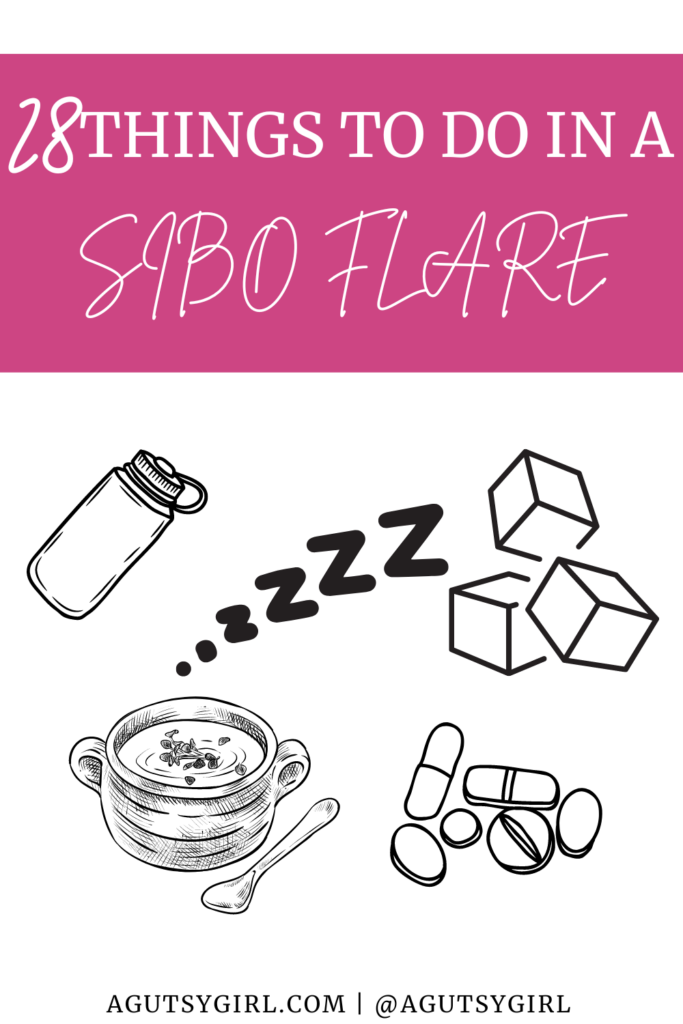
** = something I’d recommend for any type of gut flare up
1. Atrantil
I have mentioned Atrantil a few times, and while this might not be for everyone, it’s definitely been wonderful for me.
What exactly is Atrantil?
Here is how the Atrantil Website describes the product,
Atrantíl is a new nutraceutical that relieves bloating and abdominal discomfort (with or without constipation or diarrhea) caused by gas in the gut. Developed by a gastroenterologist, Atrantíl works differently than probiotics or any other remedy. It attacks problem bacteria and the gas they produce at the source. Atrantíl’s three natural botanicals work together to produce long-term relief for these difficult-to-treat digestive symptoms while promoting a healthy gut.
Atrantil works different than a probiotic because it’s not a probiotic. In fact, it’s not a probiotic, form of antibiotic treatment, or digestive enzyme.
Atrantil is most commonly used for those with SIBO. However, it’s known to target problems associated with any irritable bowel syndrome-constipation.
That said, if you are methane-dominant, it could be highly effective.
If you click HERE, you can grab it from my Fullscript online dispensary.
2. **Drink bone broth, and drink a lot of it
Broth, broth, broth. I’m an old hippie when it comes to the magic of broth.
I do not prescribe to the liquid only diets, but I do consume a lot of liquid by way of bone broths and other liquids.
I’ve been on the train since long before it was “cool.”
Here are my favorite Bone Broth Benefits:
- Rich in gelatin. And I believe in gelatin for gut healing.
- Good source of protein. I try to get as much protein as possible, but if you’ve been following along lately, it has not been dominated by meat.
- Versatile. You can do so many things with broths; from straight drinking it to making entire soup meals out of it, and even freezing it into cubes for flavor enhancers to other meals.
- Immune system boost. Because bone broth is packed with proteins (glycine and proline) that are well-known for nourishing the lining of your gut, it is thought to help give your immune system a boost.
- Nutrient dense. Bone broths contain minerals in forms that your body can easily absorb: calcium, magnesium, phosphorus, silicon, sulphur and others.
- Helps Leaky Gut Syndrome. You can read all about it in 31 Specific Things to Heal a Leaky Gut.
- Improve joints. Bone broth is a natural source of collagen, which is great for the joints.
- Maintain healthy skin. I’ve already talked about collagen and skin; because bone broth contains collagen, it’s great for the skin.
But mostly the reason most of you care about bone broth is because of its implications for digestive health.
Bone broth is great for gut healing.
There are a ton of thoughts and research out there to prove this, but I like the simplicity of how Dr. Jill said it,
Bone broth (or stock) is fabulous for healing intestinal permeability. It contains collagen, which nourishes the intestinal lining and reduces inflammation. Plus, it’s easy for a damaged gut to digest and reap the benefits of its protein and minerals.
I make my own 99.9% of the time. When I can’t, then the best way to get it in is to buy it as high-quality as possible. IMO, the best packaged bone broth is THIS.
3. NO FODMAPS (unless I’m on antibiotics)
No FODMAPS. I cut them. Plain and simple.
FODMAP is an acronym for; Fermentable Oligosaccharides, Disaccharides, Monosaccharides and Polyols. I have written on most of these before, so if you click on each one, you’ll be taken to more information on them.
The problem with FODMAPs is that they are poorly absorbed in the small intestine, which causes discomfort and many other issues for the Gutsy girl (diarrhea, gas, bloating).
Two important notes on this one, though:
- When and if I’m on SIBO antibiotics for the treatment of SIBO, I DO eat FODMAPS.
- The low-FODMAP diet has its time and place, but I do NOT recommend it for life.
4. Supplements
While flaring, my supplements became critical.
The ones that helped me most (in addition to the ones called out on this list) were:
- Digestive Enzymes – I didn’t go a meal without taking one.
- Vitamin D (K2 + D3)
- Dysbiocide – herbal supplements (Most people get it through my Fullscript online dispensary HERE.)
5. No Kombucha
Killin’ me y’all. Seriously.
I was used to drinking a bottle of booch a day, but definitely not while in a SIBO flare.
Kombucha is a fermented tea, and when dealing with small intestine bacterial overgrowth drinking beverages as such (or consuming the fermented food source counterparts) is not ideal.
At the flare stage in the game, you don’t need any help with any extra fermentation going on.
I’ve experimented with keeping kombucha in during a flare and it was miserable.
6. No Probiotics
Everyone has an opinion about this one, so I’ll share mine with you.
What is the goal of a probiotic? To supply healthy, gut-friendly bacteria to populate the intestinal wall.
But what happens when you’re trying to reduce the amount of bacteria found in the small intestine?
Debatable, but every single time I’ve taken probiotics during a SIBO flare, I’ve felt worse.
My theory is that (both probiotics and prebiotics) are only feeding and help build more of that bad bacteria, making us miserable.
That said, the second I feel like it’s eradicated or near-eradicated, especially after the use of antibiotics, I begin the probiotic supplements (THIS is the one I take) again to help build (actual) good bacteria up again.
7. **Just Breathe
We learned a few breathing techniques while at Nutrition School, but try breathing in for a few counts, hold for a few and then release for a few. Repeat several times.
I do this, but I also just stop to focus on breathing.
Furthermore, I began practicing a lot of nostril breathing, which has come in quite useful for all pieces of my life and overall health.
Getting myself into a SIBO flare up was triggered by stress, but adding more stress by not breathing certainly isn’t going to help.
There is so much power in a deep breath.
Note: an excellent book on nose breathing is THIS one, Breath: The New Science of a Lost Art, by James Nestor.
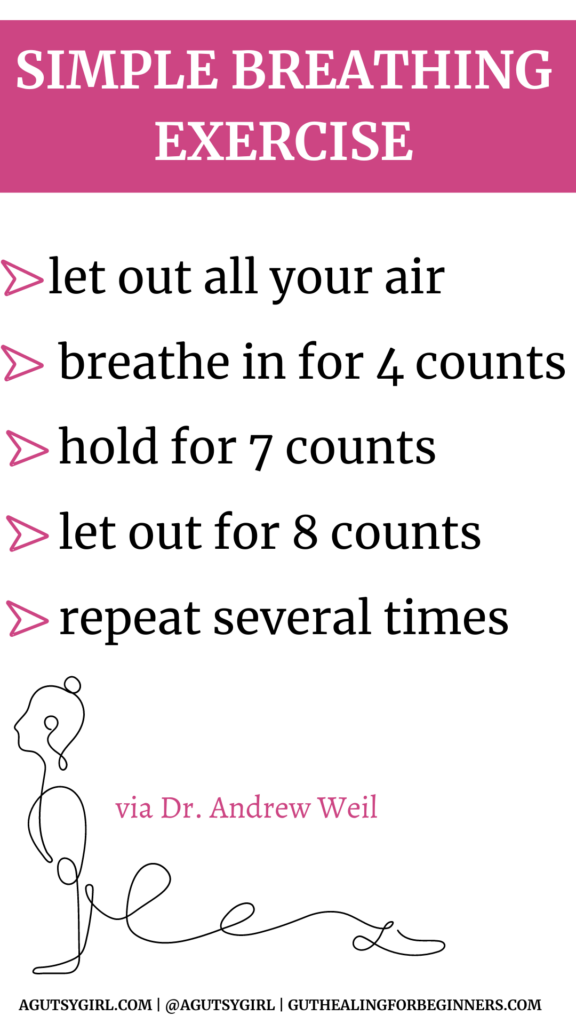
8. ** Cry
You read that correctly. Just cry.
I did this many times, and it felt good. I think of how often my children cry, but how their crying one minute might lead to total happiness the next.
Honestly, on my journey with SIBO, all the abdominal pain and unwanted side effects, I needed to cry.
It’s okay to cry over SIBO. Or anything else for that matter.
9. HCl
Low stomach acid is a root cause of SIBO. It certainly was one of mine – and I ignored it for years.
Low stomach acid, also called hypochlorhydria, is when the body doesn’t produce enough in order to break down proteins into essential amino acids and nutrients the body needs.
(By the way, there is also something known as achlorhydria, which is even lower stomach acid than hypochlorhydria.)
While studying at The Institute for Integrative Nutrition, I learned that HCL converts or activates pepsinogen to pepsin which digests proteins. HCl naturally decreases as we age. I know, such a bummer.

Despite the fact that the drug industry tells us stomach acid is a bad thing, it is not. Well, at least not always. In fact, stomach acid is needed in order to break food down.
So oftentimes people will go to their doctors, tell them they are experiencing acid reflux and they will be given an antacid and sent along their way (or worse, a PPI – proton pump inhibitor).
Neither of those things are inherently bad in and of themselves, but they are if you don’t actually have too much stomach acid.
The antacid and PPI, of course, only reduce stomach acid even more, masking a problem and causing a harsh ripple effect.
So how do you know if you have low stomach acid? HERE are 33 ways you might know.
If this is one of yours, too, a great first step is to take Betaine HCl + Pepsin with high protein meals.
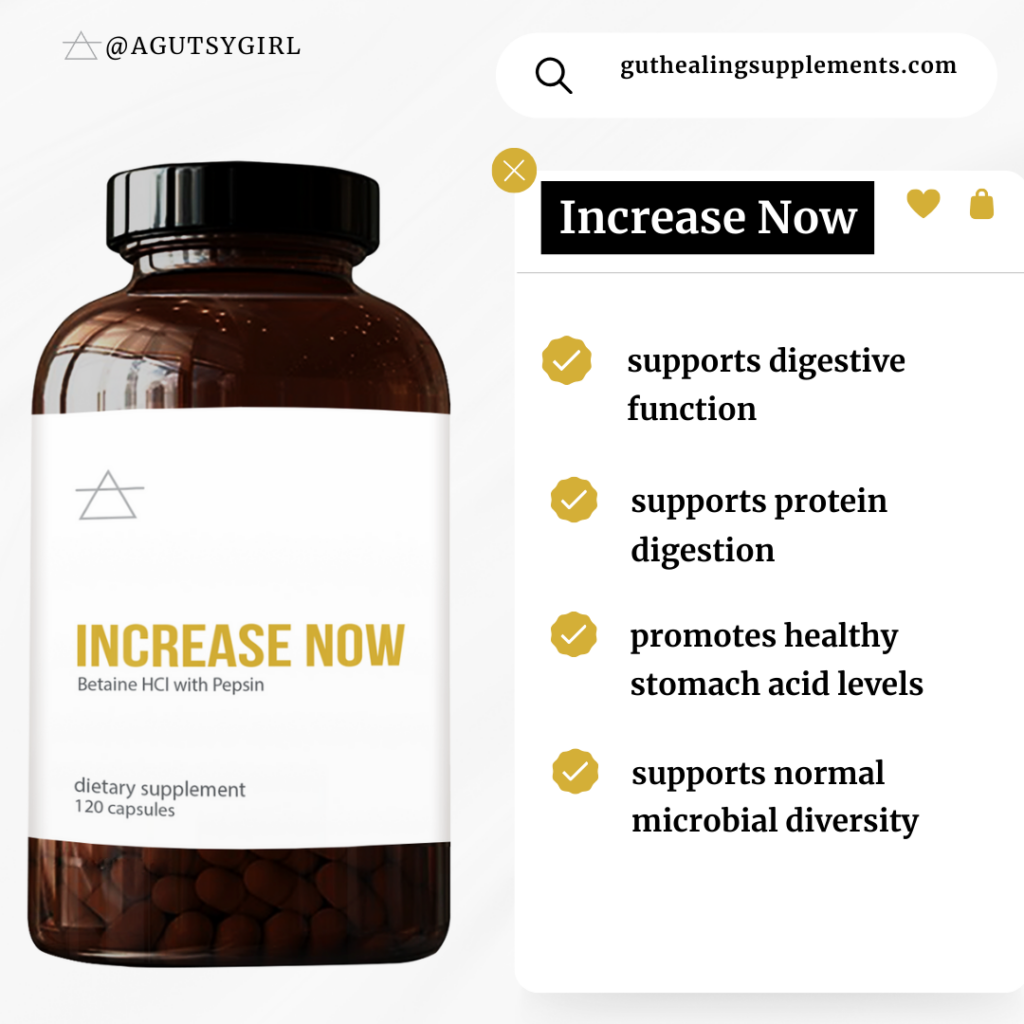
Probably the MOST important and critical supplement I take when SIBO hits with a vengeance.
10. ** Vitamin C
My friend Jen got me hooked on the power of vitamin C for the whole family, namely the children.
The purpose vitamin C serves is to act as an antioxidant, helping to protect cells from the damage caused by free radicals.
Additionally, we need vitamin C to make collagen. Collagen is a protein required to help wounds heal.
I have talked about Collagen at length HERE; wound healing was included.
Finally, vitamin C can improve the absorption of iron from plant-based foods and helps the immune system work properly to protect the body from disease.
One main group of people that Vitamin C drastically helps with are >> People with malabsorption and certain chronic diseases
In a recent Rated-G(utsy) newsletter I sent, I discussed more about absorption.
In the newsletter, I stated,
Nutrient absorption ranges from 10-90%. That’s a huge range. The determining factor? Of course, how your digestive system is functioning.Are there overgrowths? Do you have a digestive disease? Is there scarring? Are you chewing your food? And so many more things.
You can take all the vitamin C in the world, but if you are not absorbing it for any digestive reason, it won’t matter. (p.s. Be sure you’re on the newsletter list, as there is information I’ll only be sharing there moving forward.)
Some of my favorite Vitamin C brands include:
- Paleovalley Essential C Complex. It contains not one but three of the most concentrated natural sources of vitamin C: amla berry, camu camu berry, and unripe acerola cherry. Each nutrient-packed serving delivers 750% of your daily recommended intake of vitamin C – an amount meant to help you thrive, not just survive. (bonus: save 15% on this one with code AGUTSYGIRL HERE)
- Doctor’s Best. THIS is the one I have. I’ve used this one for quite some time now.
- Pure Encapsulations (Get this one for even cheaper if you are part of my Fullscript Dispensary HERE.)
- Metagenics Ultra Potent (if you want it in capsule form) (Same as above, get this one for even cheaper if you are part of my Fullscript Dispensary HERE.)
During a flare, you know all the immune support you can find.
(Do make note, though, that if you have diarrhea you must take very small doses. On the contrary, many with an overgrowth of bacteria are in fact more constipated, which means Vitamin C will play an even more crucial role. This is typically those of you with methane-dominant SIBO.)
11. ** No constricting pants
I first wrote about this idea via Unbutton Those Pants in 2012.
I stated, “By lunch, the demons began pushing against my lower belly, making even subtle movements difficult.”
The statement was referring to a time period in 2005. Both in 2005 and 2012 I had no idea that SIBO was the problem.
Tight constriction around the waist will have you feeling even worse.
Get the loose, baggy pants out because you’ll feel so much better. And if you’re wondering exactly what to wear when bloated, I have that for you HERE.)
12. Chia seeds
I can’t say this one works for everyone or for all types of flare ups, but during a SIBO flare up, I eat chia seeds.
The reason is that they are low-FODMAP and I’m not eating a ton of fiber elsewhere.
I keep it basic with a version of my gut healing chia pudding.
13. **Gelatin and collagen
I don’t care when or where or how, but I do my best to add gelatin and/or collagen (<- click that link for my Guide to Collagen vs. Gelatin) in every single day.
I recently sent out a Supplement Sunday newsletter all about collagen.
p.s. You can get on my weekly Supplement Sunday newsletter list HERE.
14. **Meal spacing and/or long nightly fasting
When you’re in a SIBO flare, you must learn to give the digestive system a break. While all the dietary changes are good, so often we forget that it’s more about how we eat vs what we are eating.
SIBO means an overgrowth in the small intestine, and that food sits there with slower gut motility and transit time to move out.
If you’re constantly eating, the food doesn’t have time to make its way out before more food gets piled on. In more technical terms, the migrating motor complex is not activated.
That’s definitely not what you want.
I have talked about meal spacing for SIBO before HERE.
For SIBO in particular, this is one of THE BEST natural remedies and hidden secrets that people don’t talk about.
In addition, I also practiced longer nightly fasting (and thus I’m also skipping early am workouts most days).
A 13-hour fast (read: Intermittent Fasting for SIBO) seems about right for me.
I stop eating at 6:30 pm and don’t eat again the next day until 7-9 am.
You’ll need to adjust for your specific needs, but the good thing is that this one won’t cost a penny.
15. **Drink water, and drink a lot of it
Keep everything moving through the system.
I used to lie about water and my consumption of it.
Each time I would go to my GI doctor, he would say,
Well are you eating enough fiber?
My reply was always, “Yes, for sure.”
(I really wanted to respond, “Look, I likely eat 2x’s as much fiber as you daily.“)
Then he would ask,
How about water? Are you drinking enough water?
Again, my reply was always, “Water. Yes, of course water. I drink it daily.”
(I still said it with the same confidence, but never acknowledged to myself that I was lying.)
Because I have never liked water. There, I said it.
Back then, because I didn’t understand how critical it was for my digestive system, I simply didn’t drink it. I likely drank no more than 8 ounces of straight up water per day. Yes, you read that right – 8 ounces.
Today I drink at least 1 gallon (which is 16 cups).
When I’m not consistently hitting those amounts, my digestive system is not as efficient.
That said, not everyone needs to drink this much. You do, however, need more than 8 ounces per day.
Make note: Drink water around meals not with meals. Drinking a lot of water with meals interferes with the natural digestive enzymes the body produces (and that you need in order to break your food down).
And if you want a super boost of hydration meets constipation hack, try my Keto Lemonade recipe HERE.
16. **Reduce or eliminate amount of skins you consume (via fruit, vegetables, etc.)
I love zucchini and green beans doused in coconut or olive oil, but before sautéing the zucchini and when I’m in a SIBO flare, I remove all skins.
Yes, normally you should try to eat the skins – that’s where the fiber lies, but remember that during a SIBO flare up, you’re not trying add any extra fibers to feed bacteria.
17. Watch the fiber consumption
And to that end, just watch fiber in general.
Because I’m so serious about this one, I put together my Top 15 Low-FODMAP High-Fiber Foods.
Because the good news is that you don’t have to give it all up!
18. **Eat nothing that contains artificial flavorings, chemicals, etc.
If the body can’t recognize something, it’s stressed.
Simply put, a food additive is a food label ingredient that would take a Chemistry degree to pronounce.
The FDA describes food additives as,
any substance the intended use of which results or may reasonably be expected to result — directly or indirectly — in its becoming a component or otherwise affecting the characteristics of any food.
In other words, a food additive does exactly what it describes: adds to food, but not necessarily in a good way.
Artificial flavorings and chemicals would fall there.
To help you navigate what these look like, check out these two lists I put together:
19. ** Reduce or eliminate sugar
One of my favorite topics to research and write about: sugar and gut health.
Why? Because sugar is literally in almost everything.
And while we (and by “we,” of course I mean me!) love sugar, I can never help but constantly question –> Does sugar contribute to a healthy gut? Or maybe the question is, ‘What does a high-sugar diet do to the gut microbiome?”
Sugar feeds all the wrong things, including harmful bacteria.
If you want my list of 192 sugar sources and alternate names, you’ll find it HERE.
You can debate sugar all you want – that it does or doesn’t matter, but if you’re going through a SIBO flare up, just try to reduce or eliminate it because I promise it will only help you heal faster.
20. **Skip the (intense) workout
In the early days of my healing, it didn’t matter if I was flaring and I had an 8-mile run on my workout calendar. I ran anyways.
Horrible, terrible, no good, very bad idea.
The truth is that I wouldn’t heal for good until I cut ties with those workouts.
p.s. Also worth reading: What I Really Think About Workouts and Gut Healing.
21. **Be careful with carbs, but also know that you do not need to completely get rid of them
This is one that I have experimented with a ton.
Mostly, and namely, with rice.
Rice is low-FODMAP and in some circles it’s now even considered Paleo, and yet it would never be GAPS or SCD, which is what many follow who have SIBO.
Root veggies are also a great source of carbs (sweet potatoes, turnips, parsnips, rutabaga).
Ironically, without failure, the root veggies almost always make me miserable and the rice is absolutely fine.
While I have personally experimented with it all, you’ll need to do the same; understand which ones work for your body and which ones do not.
You will get full exploration with these ideas in Gut Healing: ELEVATED, which is my signature course that focuses on diagnosis, diet, and lifestyle changes to HEAL for good.
22. Don’t be afraid of fat
Fat does NOT make us fat.
Fat is also essential. Sugar is not essential; fat is.
And yet, for YEARS, the low-fat movement was the “it” diet.
But what happens when something is low fat? Typically it’s also higher in carbs and sugar. And then what happened? Right. We, as a society, actually became unhealthier.
Fat is critical for things like your hormones, brain function, hair and skin quality, and even blood sugar stability.
In fact, if you have IBD-C, up the fat intake (unless you do not have your gallbladder or other risk factors as such, then that’s a whole other issue).
I started incorporating a variety of oils into my diet, and when I did that, stopped using coconut oil 24/7.
Coconut oil is constantly coming under scrutiny, but guess what? I absolutely thrive with it, so I started upping the amount of coconut oil I consume per day.
If you want to learn all about healthy fats, I have an article regarding it HERE.
23. **No alcohol
I rarely drink, and so when I do, even 2 vodka waters is good for me.
In order to understand more about the consequences of alcoholic beverages on the digestive system, first understand the basics of what alcohol is:
Ethyl alcohol, or ethanol, is an intoxicating ingredient found in beer, wine, and liquor. Alcohol is produced by the fermentation of yeast, sugars, and starches.
If you are going through a SIBO, or any, flare, you must nix the alcohol.
Read more about the harmful effects of alcohol on the digestive tract and entire body HERE.
24. **No dairy
I learned over the years (almost always the hard way) that dairy products were the last thing my body needs during a flare up.
The reason is because in order to break the milk sugar lactose down into those two compounds, we need the enzyme lactase to do so.
Lactose is not digested until it reaches the small intestine, where the hydrolytic enzyme lactase is located. Lactase (β-galactosidase) is a membrane-bound enzyme located in the brush border epithelial cells of the small intestine. Lactase catalyzes the hydrolysis of lactose into its constituent monosaccharides. SOURCE
I have an entire article on Milk Sugars which you can read HERE.
p.s. Dairy exacerbates all acne, too.
25. **Sleep
Sleep. Sleep. And then sleep some more.
Now is not the time to do 2,417 things in a day.
Your body needs rest, and it needs to find its deepest form of zero stress while simultaneously repairing.
Whatever you have to do, make sleep happen. I shoot for 8-10 hours per night.
Sleep is ESSENTIAL for healing!
And in my gut healing journaling system, I have a space for each day so you can easily track your sleep habits.
Track them and watch how your sleep will affect the way you feel on a day-to-day basis.
You can also see my sleep study as it relates to the SIBO journey and gastrointestinal symptoms HERE.
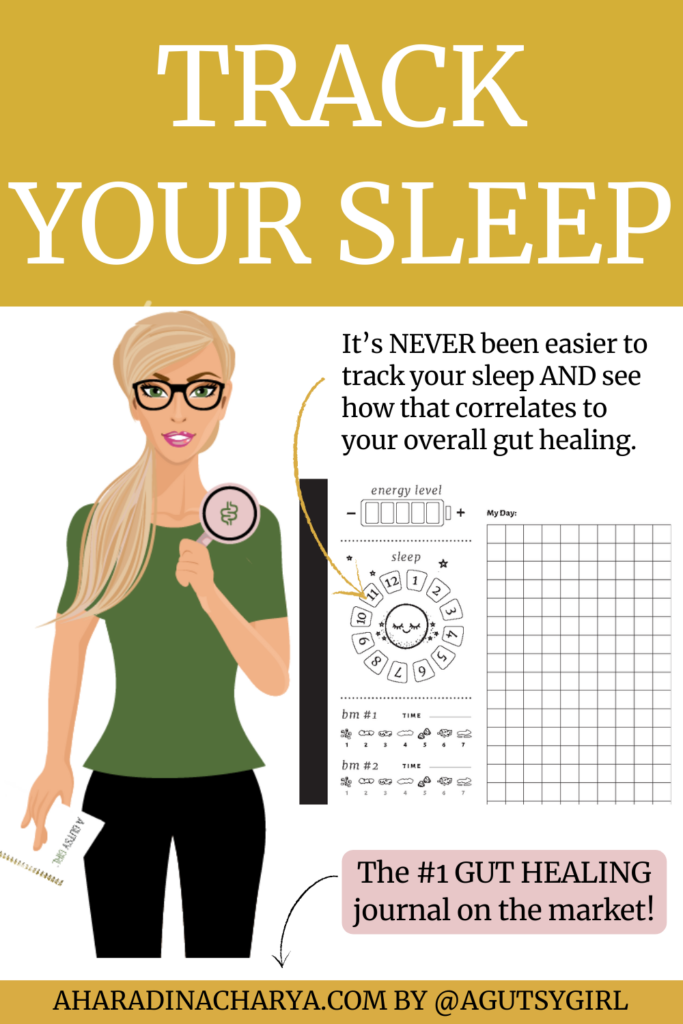
26. **Find your zen
If you can’t, or aren’t willing, to find what de-stresses you out, then no treatment plan will work in the long run.
For me, this means silence.
I find space to breathe, turn off everything and just sit.
You must find your calm place while flaring.
Read more: Yoga vs Meditation.
27. **Pray
I make no justifications that praying and my faith are and have been a huge part of my healing journey.
Jesus Christ is my true healer, but no matter what you believe, I believe you must dig deep to connect with your spiritual side during this time.
28. **Find answers, not drugs
I take LDN (Low Dose Naltrexone), and I do not hide that fact, but I’m not about to be on any and every drug just because a flare up occurs.
If every single thing on this list didn’t work and you truly worked hard at them all, then you might need more help for any given medical conditions you’re dealing with.
What I’ve found over the years, though, is that people think they are “living healthy,” and so far from it.
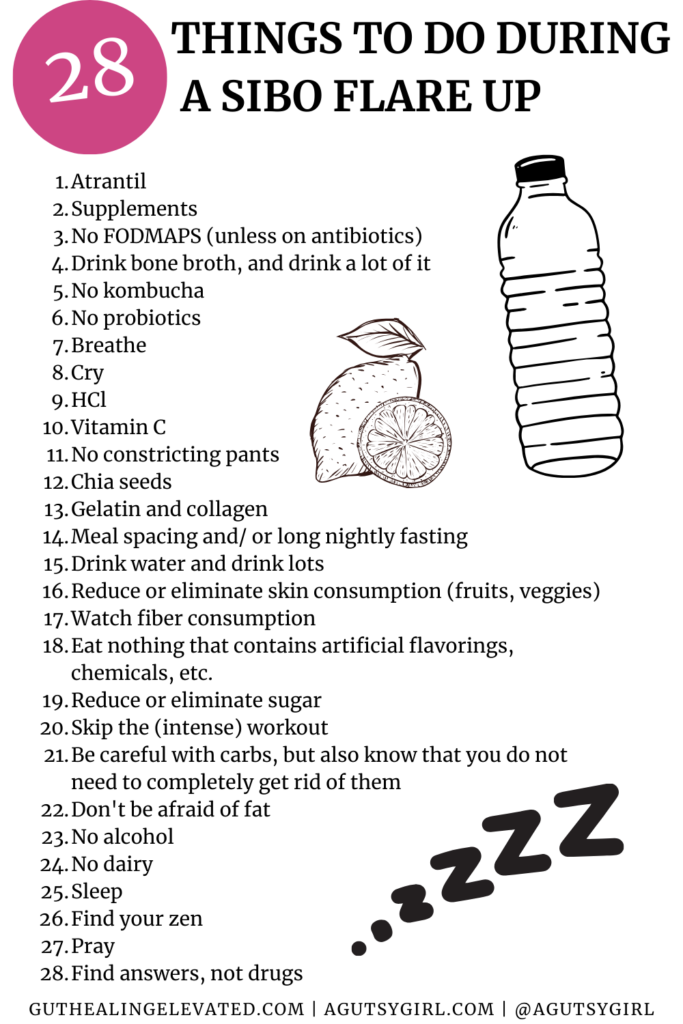
Wrap Up
Finally, when it comes to SIBO home remedies and things you can do during a flare, I will tell you this:
Give it time. SIBO didn’t occur overnight, and it won’t go away that fast either.
Get your mindset right and know, without a doubt, that the most important thing you can do long term are the LIFESTYLE things.
And if you’re TRULY desiring to expedite all of this with full access to ask the questions you want/need answered, join Gut Healing: Elevated.
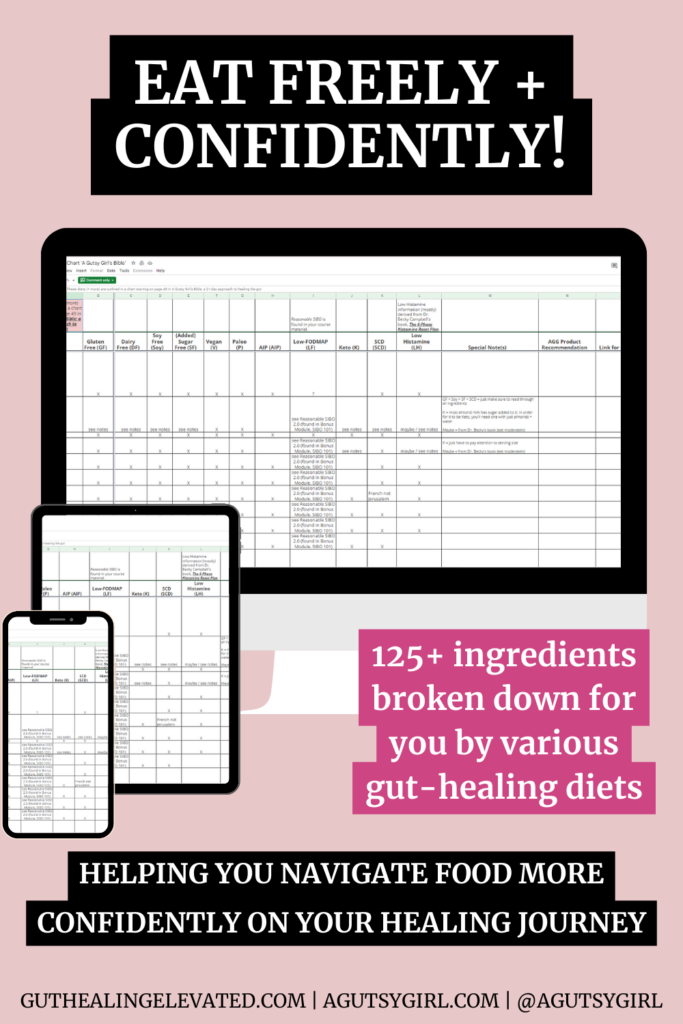


If you liked this post, you might also enjoy:
- Printable SIBO Diet (Reasonable SIBO, Heal Your SIBO)
- Best Supplements for SIBO {based off experience + research}
- FoodMarble AIRE Review
Xox,
SKH
🤰 bloating be gone! weight loss through optimal gut health for women
💃ʜᴇᴀʟ ʏᴏᴜʀ ɢᴜᴛ. ʜᴇᴀʟ ʏᴏᴜʀ ʟɪfe.
🫶🏻 founder gutbyome.com

![Gut Health Test [free and paid]](https://agutsygirl.com/wp-content/uploads/2021/07/gut-health-featured-agutsygirl.com_.png)
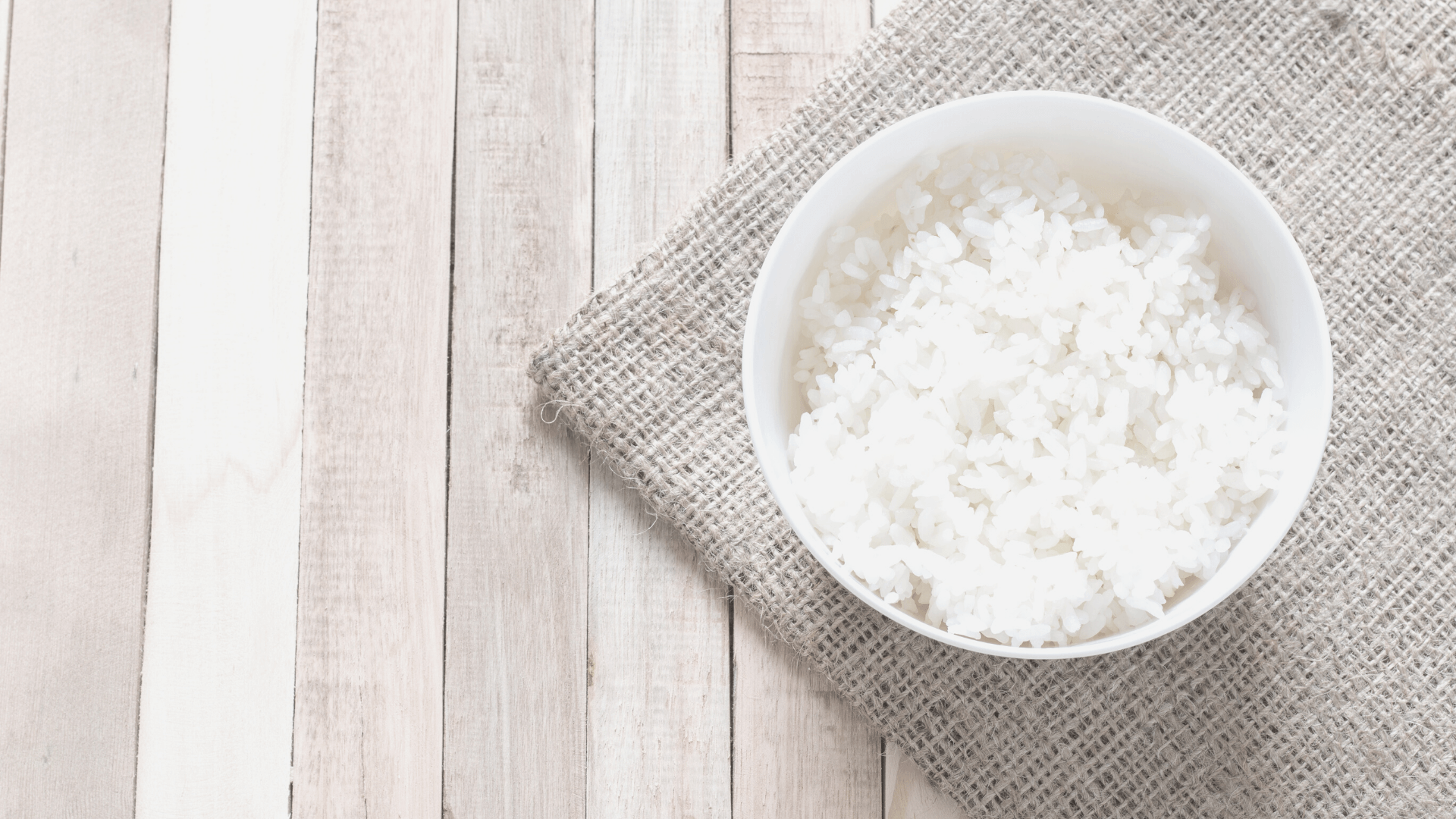
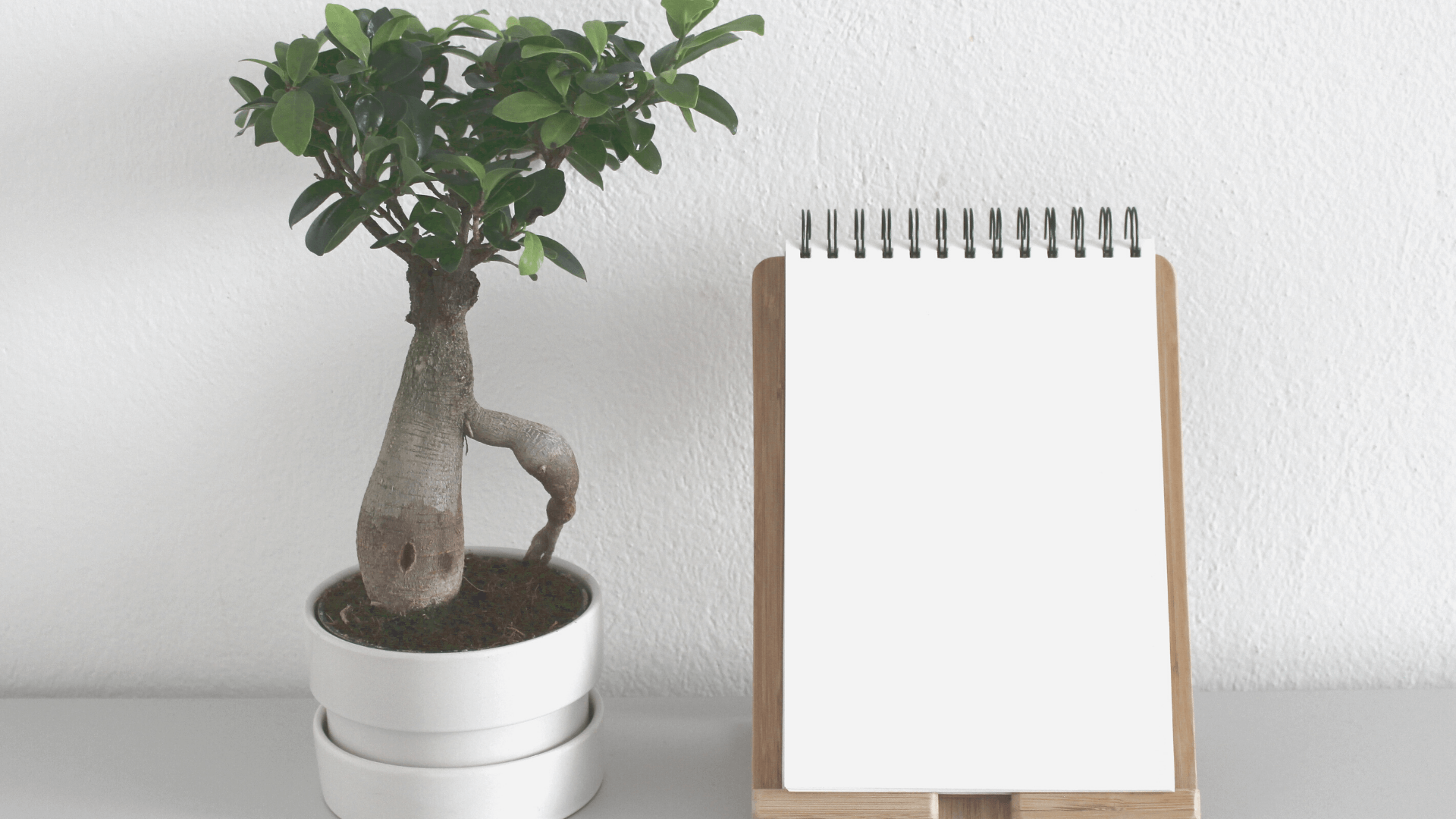



Sarah, great info, thanks! Maybe you know the answer to this Mystery. I was diagnosed w/ SIBO 4 mos. ago (Self diag. 5 yrs. ago, dealing w/ this 17 years). Xifaxan & herbals limited help, so I have been in Ketosis for ~ 6 weeks. Keto has eliminated food triggers, so stress & anxiety triggers remain. Here’s what’s weird: The Tiniest emotional trigger produces immediate gut pain, & within 15 minutes my belly goes from ~ flat to looking 6 mo. pregnant bloat. This lasts the rest of the day & sometimes the next day. This instant emotional brain to gut response started ~ 10 mos. ago, & my G.I. doc. had read about this response but couldn’t find the info on it. He said it is unusual & thinks it is probably due to a vagas nerve problem. 4 other people in a SIBO FB group I’m in said they have the same problem & are as stumped as I am. I can’t find info on this anywhere. Any thoughts on where I can learn more & find solutions? (Medical journals…). If you can help solve this, You get full credit in the different SIBO… groups I’m in! Sarah, Thank you So much! – Allison (aapayte@aol.com) <3!
I have this issue too. As soon as I have a gut pain my anxiety and panic attacks go full throttle. I develope nausea, dry heaves, body shakes, sweating, dry mouth, diarrhea. You name it. I will sit in that panic attack for hours trying to get a grip on it till the food is digested. For me I know I have a cortisol issue as we have more receptors in our gut. They are going to recheck my thyroid and other hormone glands.
What is the probiotic you take? The link would not come up to show this. Thanks.
Hi Debbie! Here you go –> http://agutsygirl.com/resources/recommended-supplements/ Xox
Hi! Thank you so much for this!! How long are your flare ups or what is average?
Hi,
can i also drink the bonebroth with hisatimintolerance?
Did i understood right, with these thing you lost all the symptoms in three days?
Some can tolerate bone broth with a histamine intolerance; others cannot. You’ll need to see if it works for you or not.
Hey, great post. Funny because I always go straight to bone broth and chia pudding during a flare up and it helps me within days. Its magical!!
So good, right?! Thanks for stopping by.
Hi and thanks for posting this! I do have a question now about the bone broth. I’ve heard and read quite a bit this year about something released specifically from the bones that is irritating for SIBO ( I forgot exactly what) and to stay away from bone broth (regular chicken broth ok, just no bones). Have you heard this or have any updated info? Thanks!
Hi Christine – typically people are referring to histamines. However, are you intolerant to histamines? If not, you should be fine.